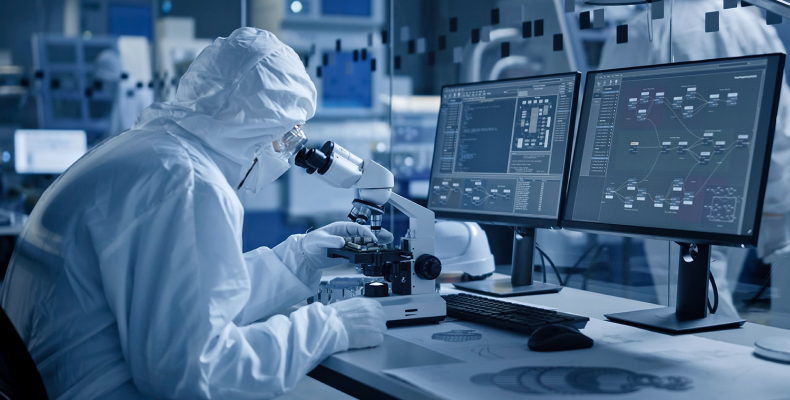ERP (Enterprises Resource Planning) systems assist with everyday tasks like accounting, risk management, supply chain, etc. LIMS (Laboratory Information Management Software) automates the framework, samples management, test results storage and transmission, lab data collecting and storage, etc.
LIMS integration: Benefits & how it works

Mykhaylo Terentyak
Author

March 11, 2024
Date

 12 minutes read
12 minutes read
Content
The amount of data generated by modern genomics is more significant than ever. Its volumes are enormous, and labs face the need to modernize their approach to working with this data, managing it, centralizing, and tracking.
This blog post will walk you through the short LIMS software development guidance. It includes various points to consider LIMS implementation, introduces you to its benefits, and helps you to make a choice — how to choose LIMS for your laboratory.
What is a Laboratory Information Management System (LIMS)?
A LIMS is a specific software laboratories use to reach higher management samples and related data levels. Using LIMS, lab workers can track data across experiments, benefitting efficiency and allowing greater flexibility. It even helps in better-organized workflows.
What is LIMS integration?
LIMS are widely used by organizations specializing in research and development — universities, research organizations, biobanks, clinical research facilities, etc.
A LIMS system is similar in function to the well-known CRM systems. All organizations rely on software to manage their processes and data. Why wouldn’t labs do the same? They work with vast amounts of data and strive for maximum accuracy.
Core features of a LIMS that enable better lab management
1. Sample management and tracking, admission control
A LIMS takes care of sample tracking from A to Z. However, its capabilities are not limited by this. It also assists in shipment, admission control, and inventory processes. It ensures sample integrity and data quality.
2. Lab management
Lab management is one of the main benefits of LIMS. Its capabilities can be divided into three main categories, including different functionality.
- Inventory management allows tracking of reagents and consumables, their location, and availability. It’s possible to assign automatic reorder alerts.
- Instrument management helps to monitor instrument status in the lab. It schedules calibrations and maintenance based on workload. It results in optimization uptime and resourcing.
- Lab health means constant observation and management of all the lab resources. The overview of the lab’s status is presented on dashboards, based on data, and updated in real-time.
3. Compliance
For labs, it’s vital to comply with internal and external regulations. LIMS makes it easier with its constant tracking of data and metadata required to support compliance.
4. Workflow capabilities
Managing and synchronizing all the processes in one lab is sometimes challenging and overwhelming. While working with LIMS, you can reflect the workflow in graphics and automate routine or repeatable processes. The need for user intervention becomes less significant. Lab specialists can focus on more complex tasks or move to the next ones.
5. Cross-department collaboration
In cases where there are different labs in various locations, the possibility to share data and get access to it in real-time is life-changing. Regardless of the physical location, anyone can access a database immediately.
6. Enterprise systems integration
Enterprise systems such as LIMS Enterprise Resource Planning (LIMS ERP) and similar are vital to many modern labs. Having LIMS integrated with these systems, you can access various data sources automatically.
7. Responsive deployment
LIMS can be deployed in multiple ways now. Which one to choose depends on the organization’s requirements for data management and a long-term IT strategy. The integration can be on-premises or via a managed cloud.
8. Data security
Security is a number one priority for any organization, and labs are not an exclusion. LIMS handles data security and archival perfectly and in full compliance with regulatory requirements.
9. Data visualization
There are more options to display data now than we could imagine a few years ago. LIMS software enables sharing, analyzing, auditing, reporting, and graphic representation of data. An ideal LIMS also offers dashboards to present information and provides lab performance and assigned work overviews.


Ready to streamline your laboratory workflows?
Contact us today to discuss your LIMS integration needs
Benefits of LIMS integration
Understanding the core features gives a picture of how beneficial LIMS integration with ERP and MES might be for the organization. In summary, its most prominent benefits of lims include the following:
- It allows better staff management and assignment. It’s possible by reducing the amount of time required to enter data, group them, or calculate.
- Reduces the possibility and amount of errors.
- Improves turnaround time.
- Provides a clear picture of the lab’s WIP status that helps identify and eliminate bottlenecks.
- Provides a basis for setting up a notification framework. It enables automatic alerting for unusual events.
- Helps labs correspond with data management requirements.
- Makes it possible to run statistical analysis on vast amounts of data.
- Allows real-time data access to various departments.
- Streamlines quality sample storage and the COA generation and delivery.

Systems and instruments that are capable of LIMS integration
Different laboratories use various tools and software that can be integrated with LIMS. However, it’s not an obligation; the process might be time-consuming. Your organization should weigh up the importance of each one, the efforts, and the benefits. The systems you can potentially integrate with LIMS include:
Informatics products. Systems like Chromatography Data Systems (CDS) and an Electronic Lab Notebook (ELN) assist in data integrity. Most LIMS have ELN integrated; some also offer to integrate Scientific Data Management Systems (SDMS). If your LIMS has the integrations built in for systems you plan to use, these should be incorporated during the implementation.
Manufacturing systems. Integrating LIMS Enterprise Resource Planning (LIMS ERP) software like the Manufacturing Execution System (MES) makes sense if your manufacturing lines operate 24/7. Otherwise, the technical challenges aren’t worth undertaking.
Platform as a service (PaaS). This platform integrates your LIMS and CDS, ERP, or MES systems. The point in its favor is that this platform can be administered by the in-house IT team, not specifically by the LIMS or ERP.
Among instruments capable of LIMS integration are pH meters, barcode readers, walk-in freezers, and similar ones. Configuring the instrument management and calibration module automates scheduling instrument calibration and maintenance. It also allows you to track their performance easily in real-time.
Best practices for integrating LIMS
There are different ways and practices of LIMS integration. They depend on requirements, a set of systems and tools to integrate, and the organization’s objectives and capabilities. However, some can be called universal since they apply to LIMS implementation of any kind. Those are the following:
Define your small and big objectives
Any LIMS implementation starts with an understanding of the final and intermediate goals. Always ensure your LIMS objectives are aligned with the lab’s ones.
Create the requirements list
Define the main requirements of the LIMS solution. You need to have a complete understanding of the processes and workflows in your lab. The main requirements for a LIMS solution will cover many business and lab users’ needs, data management, and IT requirements. Getting a clear picture of the data types and formats the LIMS will need to work with is vital. Assumptions on this part can cause significant problems after the implementation.
It’s recommended to focus on the main requirements initially and move to additional ones after the successful implementation.
Find a reliable expert
Deciding on the best LIMS platform and its implementation is complex and challenging. To reduce the risks related to wrong decisions, it’s better to ask for expert assistance.
A third-party expert provides independent advice on the numerous available LIMS solutions, workflow optimization, hardware and software compatibility, data security, etc.
Work on a business case
A business case is required to get a sign-off on the investments in the LIMS. While working on it, it’s essential to focus on the benefits for the lab and the company in general and demonstrate ROI.
Stick to your implementation plan
A good LIMS implementation project manager takes care of the project controls. Workflow and governance management, stakeholder involvement, and timelines are their responsibilities. To make it possible, deliver your implementation plan to everyone involved.
While working on the plan, take care of risk management, data migration, and testing, and add sufficient timeframes. Don’t forget to include unforeseen circumstances and data backup.
Verify your software
To meet the regulatory requirements, you might need to verify your software. Take care of it in the early phases of the LIMS implementation so that your essential documentation won’t need any changes or clarification during the process.

Types of LIMS integration
There are different types of LIMS integration. One-fit-all is not a thing; choosing the best option should rely on the lab’s requirements and the organization’s objectives. LIMS can be integrated with:
- Lab instruments such as blood chemistry analyzers and hematology analyzers. Having them implemented, you can automatically transfer the test results to the LIMS system. This approach eliminates manual data entry and all related risks. It’s also an outstanding time-saver.
- EMR systems to reach fast and uninterrupted data exchange between labs and other departments. Creating an electronic order and automatically getting the results in the EMR is possible. Thanks to this approach, the level of communication and provided services increases.
- Molecular diagnostic platforms like PCR (Polymerase Chain Reaction) instruments and Next-Generation Sequencing (NGS). LIMS integration with those systems enables test data capturing and facilitates its interpretation. The analysis of genetic or molecular test results takes less time and can be presented with graphic materials.
- Third-party API to facilitate cooperation with corporates and insurance companies, finance systems, etc. They help exchange information with laboratories and effectively operate with different data within various networks.
How LIMS integration automates laboratory operations
LIMS integration is crucial in upgrading and simplifying laboratory workflows. It enables efficient sample tracking and management, streamlines reporting, facilitates data analysis, and improves laboratory productivity by automating and optimizing various processes. For example:
Integration with sample tracking systems and barcode scanners makes it easy to identify samples accurately. It also allows location tracking.
Integration with instruments eliminates manual data entry. It leads to fewer errors related to human factors and saves a lot of time. Test results and instrument parameters can be automatically captured and transmitted to the storage of the LIMS system.
LIMS system integration also facilitates workflow management. It automates repetitive tasks like sample registration, assignment, scheduling, and reporting. This eliminates the need for manual work and saves time.
Integrated LIMS systems can go with advanced data analysis tools. With their help, scientists can get insights from massive datasets. With the reporting tools, you can create customized reports related to specific data types, workflows, or requirements.
How do you integrate with LIMS?
Each step in the LIMS software implementation process requires a qualified project team. It includes business analysts, solution architects, third-party integration experts, etc.
Let’s look at the main stages of the LIMS implementation:
Requirements definition
At the very first stage, it’s vital to point out the existing and prospective lab requirements. This information will be used as pillars for all the following stages of the implementation process.
Some of the leading lab requirements are:
- Regulatory compliance for a clinical LIMS
- Accurate request management
- Access control for data protection
- Instrument integrations
- Advanced reporting and data visualization
- KPI tracking
Before migrating, evaluate the pitfalls of your current software — research how the new platform can address them and improve lab performance and insights.
Project planning
Delving into the implementation stage without a thorough project plan may result in insufficient results and not meeting the budget and time frames. The LIMS implementation project plan should include a precise time estimate, key performance metrics, LIMS developer options, etc.
Determine the MVP (Minimum Viable Product) for an efficient system implementation. It includes core LIMS functionalities needed for your specific lab. Thus, you can ensure instant productivity and add the advanced capabilities later when the staff gains experience.
Data migration
Considering the system’s data migration in the early stages is critical to a successful LIMS implementation. Data migration is not a requirement, but even a minimal migration has the potential to provide a significant value. The new system will start operating having essential lab information.
The critical experiment data must always be migrated from the legacy system to a new one.
Configuration
All the processes in a lab are different. This means they have different requirements. Your vendor must document the software configurations so the new system complies with the defined conditions. This configuration is based on the technical procedure and arrangements in a lab.
The process might take from six to eighteen months. Here, we discuss the complete LIMS deployment process with data migration and proper configuration. The duration depends on the required configuration level and the amount of master data.
Running test cases
This stage’s primary mission is to ensure all the software functionality aligns with the requirements and specifications. It helps to ensure the quality of the system and its compatibility with the data regulations.
The more configurations you request, the more time the testing process will take.
Testing user acceptance
When the system is ready, you have to take care of training its users. Quality training is key to successful operation and getting the most out of the product. To cover all the parts, ask the LIMS implementation services provider you work with for the training documentation, tutorials, etc.

Conclusion
It’s hard to imagine a modern lab working without LIMS. It offers automation of workflow management, secure data storage, fast and safe access to requested data from different departments in different locations, accurate task completion, valuable tools, and convenient data visualization.
Integrating LIMS enhances a lab’s capabilities, making it an excellent advantage for any forward-looking laboratory.
LIMS integration with Blackthorn Vision
At Blackthorn Vision, we help laboratories find the most efficient way to integrate and customize LIMS. As a final goal, we take the most possible level of automation, the highest level of security and management. We focus on the organization’s specifics and objectives to find the best integration LIMS. In parallel, we offer integration of systems and tools the lab uses or will use to reach the highest efficiency, accuracy, and overall performance. It all results in providing better services.
FAQ
Is LIMS an ERP system?
What are the benefits of integrating instruments with LIMS?
The benefits of using a LIMS are many. The most prominent of them are the following:
– Management of the vast amount of data.
– Higher quality of generated data.
– High level of security of the stored data.
– Processes automation.
– Improved cross-department communication.
Why are LIMS important for modern labs?
Today, LIMS is a critical component of secure and effective laboratory operations. It helps to automate numerous manual processes, frees up time and resources, and reduces the possibility of human factor-related mistakes and limitations. In general, it provides a consistent and efficient working environment.
How to choose a LIMS?
The best LIMS is the one that aligns with the business, its type, size, and objectives. It has also aligned with the organization’s IT infrastructure and workflows. The third factor is the requirement list — what you expect to achieve with LIMS implementation.





































































